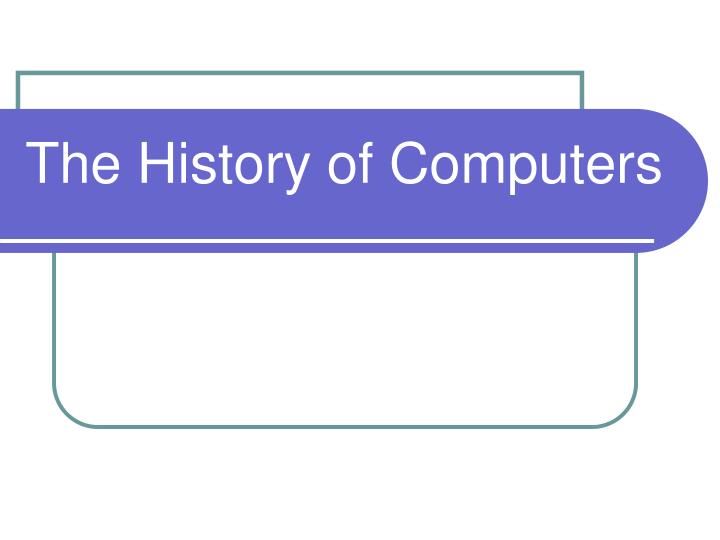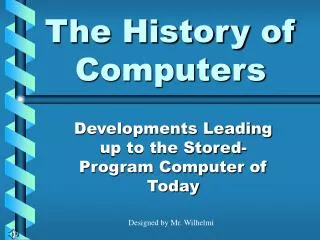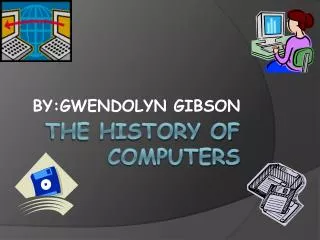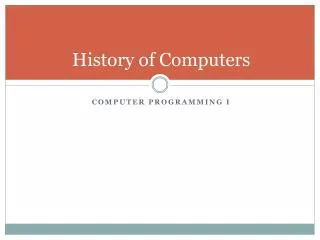

The History of Computers
Mar 26, 2019
3k likes | 8.01k Views
The History of Computers. History of computing. calculating devices have been around for millennia (e.g., abacus ~3,000 B.C.) modern "computing technology" traces its roots to the 16-17th centuries
Share Presentation
- partial vacuum
- most computers today
- limited capabilities
- produce tapestries
- new switching technologies

Presentation Transcript
History of computing • calculating devices have been around for millennia (e.g., abacus ~3,000 B.C.) • modern "computing technology" traces its roots to the 16-17th centuries • as part of the "Scientific Revolution", people like Kepler, Galileo, and Newton viewed the natural world as mechanistic and understandable • this led to technological advances & innovation • from simple mechanical calculating devices to powerful modern computers, computing technology has evolved through technological breakthroughs
Generation 0: Mechanical Computers 1642 – Pascal built a mechanical calculating machine • used mechanical gears, a hand-crank, dials and knobs • other similar machines followed • 1805 – the first programmable device was Jacquard's loom • the loom wove tapestries with elaborate, programmable patterns • a pattern was represented by metal punch-cards, fed into the loom • using the loom, it became possible to mass-produce tapestries, and even reprogram it to produce different patterns simply by changing the cards • mid 1800's – Babbage designed his "analytical engine" • its design expanded upon mechanical calculators, but was programmable via punch-cards (similar to Jacquard's loom) • Babbage's vision described the general layout of modern computers • he never completed a functional machine – his design was beyond the technology of the day
Generation 0 (cont.) 1890 – Hollerith invented tabulating machine • designed for tabulating 1890 U.S. Census data • similar to Jacquard's loom and Babbage's analytical engine, it stored data on punch-cards, and could sort and tabulate using electrical pins • using Hollerith's machine, census data was tabulated in 6 weeks (vs. 7 years for the 1880 census) • Hollerith's company would become IBM • 1930's – several engineers independently built "computers" using electromagnetic relays • an electromagnetic relay is physical switch, which can be opened/closed via electrical current • Zuse (Nazi Germany) – his machines were destroyed in WWII • Atanasoff (Iowa State) – built a partially-working machine with his grad student • Stibitz (Bell Labs) – built the MARK I computer that followed the designs of Babbage • limited capabilities by modern standards: could store only 72 numbers, required 1/10 sec to add, 6 sec to multiply • still, 100 times faster than previous technology
Generation 1: Vacuum Tubes mid 1940's – vacuum tubes replaced relays • a vacuum tube is a light bulb containing a partial vacuum to speed electron flow • vacuum tubes could control the flow of electricity faster than relays since they had no moving parts • invented by Lee de Forest in 1906 • 1940's – hybrid computers using vacuum tubes and relays were built COLOSSUS (1943) • first "electronic computer", built by the British govt. (based on designs by Alan Turing) • used to decode Nazi communications during the war • the computer was top-secret, so did not influence other researchers ENIAC (1946) • first publicly-acknowledged "electronic computer", built by Eckert & Mauchly (UPenn) • contained 18,000 vacuum tubes and 1,500 relays • weighed 30 tons, consumed 140 kwatts
Generation 1 (cont.) COLOSSUS and ENIAC were not general purpose computers • could enter input using dials & knobs, paper tape • but to perform a different computation, needed to reconfigure • von Neumann popularized the idea of a "stored program" computer • Memory stores both data and programs • Central Processing Unit (CPU) executes by loading program instructions from memory and executing them in sequence • Input/Output devices allow for interaction with the user virtually all modern machines follow this von Neumann Architecture (note: same basic design as Babbage) programming was still difficult and tedious • each machine had its own machine language, 0's & 1's corresponding to the settings of physical components • in 1950's, assembly languages replaced 0's & 1's with mnemonic names e.g., ADD instead of 00101110
Generation 2: Transistors mid 1950's – transistors began to replace tubes • a transistor is a piece of silicon whose conductivity can be turned on and off using an electric current • they performed the same switching function of vacuum tubes, but were smaller, faster, more reliable, and cheaper to mass produce • invented by Bardeen, Brattain, & Shockley in 1948 (earning them the 1956 Nobel Prize in physics) some historians claim the transistor was the most important invention of the 20th century • computers became commercial as cost dropped high-level languages were designed to make programming more natural • FORTRAN (1957, Backus at IBM) • LISP (1959, McCarthy at MIT) • BASIC (1959, Kemeny at Dartmouth) • COBOL (1960, Murray-Hopper at DOD) the computer industry grew as businesses could afford to buy and use computers Eckert-Mauchly (1951), DEC (1957) IBM became market force in 1960's
Generation 3: Integrated Circuits mid 1960's - integrated circuits (IC) were produced • Noyce and Kilby independently developed techniques for packaging transistors and circuitry on a silicon chip (Kilby won the 2000 Nobel Prize in physics) • this advance was made possible by miniaturization & improved manufacturing • allowed for mass-producing useful circuitry 1971 – Intel marketed the first microprocessor, the 4004, a chip with all the circuitry for a calculator • 1960's saw the rise of Operating Systems • recall: an operating system is a collection of programs that manage peripheral devices and other resources • in the 60's, operating systems enabled time-sharing, where users share a computer by swapping jobs in and out • as computers became affordable to small businesses, specialized programming languages were developed Pascal (1971, Wirth), C (1972, Ritche)
Generation 4: VLSI late 1970's - Very Large Scale Integration (VLSI) • by the late 1970's, manufacturing advances allowed placing hundreds of thousands of transistors w/ circuitry on a chip • this "very large scale integration" resulted in mass-produced microprocessors and other useful IC's • since computers could be constructed by simply connecting powerful IC's and peripheral devices, they were easier to make and more affordable
Generation 4: VLSI (cont.) • with VLSI came the rise of personal computing • 1975 - Bill Gates & Paul Allen founded Microsoft Gates wrote a BASIC interpreter for the first PC (Altair) • 1977 - Steve Wozniak & Steve Jobs founded Apple went from Jobs' garage to $120 million in sales by 1980 • 1980 - IBM introduced PC Microsoft licensed the DOS operating system to IBM • 1984 - Apple countered with Macintosh introduced the modern GUI-based OS (which was mostly developed at Xerox) • 1985 - Microsoft countered with Windows 1980's - object-oriented programming began • represented a new approach to program design which views a program as a collection of interacting software objects that model real-world entities • Smalltalk (Kay, 1980), C++ (Stroustrup, 1985), Java (Sun, 1995)
Generation 5: Parallelism/Networks the latest generation of computers is still hotly debated • no new switching technologies, but changes in usage have occurred high-end machines (e.g. Web servers) can have multiple CPU's • in 1997, highly parallel Deep Blue beat Kasparov in a chess match • in 2003, successor Deep Junior played Kasparov to a draw • most computers today are networked • the Internet traces its roots to the 1969 ARPANet mainly used by govt. & universities until late 80's/early 90's • the Web was invented by Tim Berners-Lee in 1989 designed to allow physics researchers to share data and documents not popular until 1993 when Marc Andreessen developed a graphical browser (Mosaic) Andreessen would go on to found Netscape, and Internet Explorer soon followed stats from NetCraft & Internet Software Consortium
From Circuits to Microchips • initially, circuits were built by wiring together individual transistors • this did not lend itself to mass production • it also meant that even simple circuits consisting of tens or hundreds of transistors were quite large (to allow space for human hands) • in 1958, two researchers (Jack Kilby and Robert Noyce) independently developed techniques that allowed for the mass-production of circuitry • circuitry (transistors + connections) is layered onto a single wafer of silicon, known as a microchip • since every component is integrated onto the same microchip, these circuits became known asintegrated circuits
Manufacturing ICs • the production of integrated circuits is one of the most complex engineering processes in the world • transistors on chips can be as small as .13 microns (roughly 1/750th the width of human hair) • since a hair or dust particle can damage circuitry during manufacture, chips are created in climate-controlled "clean rooms"
Manufacturing ICs • to produce the incredibly small and precise circuitry on microchips, manufacturers use light-sensitive chemicals • initially, the silicon chip is covered with a semiconductor material, then coated with a layer of photoresist (a chemical sensitive to UV light) • transistors are then printed onto a mask (transparent surface on which an opaque coating has been applied to form patterns) • UV light is filtered through the mask, passing through the transparent portions and striking the surface of the chip in the specified pattern • the photoresist that is exposed to the UV light reacts, hardening the layer of the semiconductor below it • the photoresist that was not exposed and the soft layer of semiconductor below are etched away, leaving only the desired pattern of semiconductor material on the surface of the chip • the process can be repeated 20-30 times depositing multiple layers
Packaging Microchips • since a silicon chip is fragile, the chip is encased in plastic for protection • metal pins are inserted on both sides of the packaging, facilitating easy connections to other microchips • impact of the microchip • lower cost due to mass production • faster operation speed due to the close proximity of circuits on chips • simpler design/construction of computers using prepackaged components • Moore’s Law describes the remarkable evolution of manufacturing technology • Moore noted that the number of transistors that can fit on a microchip doubles every 12 to 18 months • this pattern has held true for the past 30 years • industry analysts predict that it will continue to hold for the near future
- More by User

The history of computers
The history of computers. By: josh Evans. The ancestry of computers.
331 views • 8 slides

The History of Computers. Developments Leading up to the Stored-Program Computer of Today. Designed by Mr. Wilhelmi. In The Beginning. Early humans counted on their fingers – evolution of base 10 numbering system. Abacus Orient. 3000 years ago First calculating mechanism
1.9k views • 24 slides

The history of computers . Dr. John V. Atanasoff and Clifford Berry design and build the first electronic digital computer. Their machine, the Atanasoff-Berry-Computer, or ABC, provides the foundation for advances in electronic digital computers. 1937.
484 views • 11 slides

The History of Computers . The History of Computers. By: Chandler Jones. 1939.
703 views • 9 slides

The History of Computers. Hardware, Software, Programs, Computers Safety Tips, and Computer Ethics . Hardware. Hardware is a general term for the physical artifacts of a technology.
262 views • 7 slides

The History Of computers
The History Of computers. By: James Jones.
208 views • 9 slides


THE HISTORY OF COMPUTERS
BY:GWENDOLYN GIBSON. THE HISTORY OF COMPUTERS. ESSENTIAL COMPONENTS.
430 views • 26 slides

History of Computers
History of Computers. Computer Programming I. Mechanical Devices. Pascaline (1642) Set of gears, similar to clock Only performed addition Stepped Reckoner Gottfried Leibniz Cylindrical wheel with movable carriage Add, subtract, multiply, divide, square roots Jammed/malfunctioned.
816 views • 17 slides

History of Computers. Timeline Presented by: Amanda and Andy. Earliest forms . 300 B.C.: The abacus is believed to have been the earliest known calculating device. AD 1625: The Slide rule was able to perform mathematical calculations.
947 views • 24 slides

History of Computers. Image Gallery. 2000 BC--Abacus. 1642--Pascal’s Adding Machine. 1725—Punch Cards. oldest known form of data storage is from 1725 and was done by Basile Bouchon when he used a perforated paper loop to store patterns that were to be used on cloth.
9.15k views • 27 slides

History of Computers. By: Evan Alderman. What will we be talking about today?. Slide 3 & 4: Early computers Slide 5: ARPA Slide 6 & 7: ARPANET & the Internet Slide 8: Packets & Convergence Slide 9: The “Killer App” (E-mail) Slide 10: The World Wide Web Slide 11: Today’s computing .
887 views • 12 slides

The History of Computers. By TechnoKids Inc. Introduction.
484 views • 13 slides

The History of Computers. By Marc Kliebert. Important eras in the development of computers. Pre-History Electronics Mini Micro. PRE-HISTORY ERA 4th century B.C. to 1930s. The abacus is believed to have been invented in 4 th century B.C.
876 views • 31 slides

The history of Computers
The history of Computers. By Catie Pool Info Tech 3 rd period. 1822-1888.
305 views • 11 slides

The History of Computers. Evolution of Mechanical Computers. A computer is An electronic device for the storage and processing of information a programmable machine that inputs, processes and outputs data
406 views • 11 slides

The History of Computers. By: Jacob Printz. The Beginning of Computers.
254 views • 6 slides

The History of Computers. Click here for inventors. Presented to you by : CEO-Josh R. Technical Advisor & Editor-Shan P. Artistic Director-Jeremiah M. And researchers-Mike D., Allen N., Nathan A., Chris Z., and TC S. Blaise Pascal. His inventions.
613 views • 32 slides

The History of Computers. The 1980s. 1980. Tim Patterson writes 86-QDOS, an operating system for personal computers. Microsoft licenses this program from Patterson and to IBM. It becomes an industry standard under the name of DOS. 1981.
265 views • 6 slides

The History of computers
The History of computers. By Kendall PIT Per- 7 th. The First Computer. First programmable computer: -The Z1 -created in Germany by Konrad Zuse in his parents living room in 1936 to 1938 -was made to help with lengthy engineering equations. - had 64 word memory
473 views • 12 slides

The History of Computers. (or “How we’ve come a long way in a short time.”). Alienware’s 4GHz ALX. What is a computer?.
808 views • 34 slides

The History of Computers. Jack MaGee. What Basic Tasks Does a Computer Perform. - Help research and find information - A form of communication - A form of entertainment - Makes life easier in general. The First Computers. A list of the computers ancestors - Adacis
354 views • 9 slides

The History of Computers. Reasons for learning how to use a computer. To develop problem-solving skills To become aware of their capabilities and limitations To develop an invaluable skill to be used at home and at work. 1.1 What is a Computer?.
700 views • 36 slides
- Preferences

A HISTORY OF THE COMPUTER - PowerPoint PPT Presentation

A HISTORY OF THE COMPUTER
A history of the computer five eras in computer development pre-history electronics mini micro network pre-history era 4th century b.c. to 1930s the abacus is ... – powerpoint ppt presentation.
- Pre-History
- Electronics
- The abacus is believed to have been invented in 4th century B.C.
- The Antikythera mechanism, a device used for registering and predicting the motion of the stars and planets, is dated to 1st century B.C.
- Arabic numerals were introduced in Europe in the 8th and 9th century A.D. and was used until the 17th century.
- John Napier of Scotland invents logs in 1614 to allow multiplication and division to be converted to addition and subtraction.
- Wilhelm Schickard, a professor at the University of Tubingen, Germany builds a mechanical calculator in 1623 with a 6-digit capacity. The machine worked, but it never makes it beyond the prototype stage.
- Leonardo Da Vinci is now given credit for building the first mechanical calculator around 1500. Evidence of Da Vincis machine was not found until papers were discovered in 1967.
- Blaise Pascal builds a mechanical calculator in 1642 with an 8-digit capacity.
- Joseph-Marie Jacquard invents an automatic loom controlled by punch-cards in the early 1800s.
- Charles Babbage designs a Difference Engine in 1820 or 1821 with a massive calculator designed to print astronomical tables. The British government cancelled the project in 1842 Babbage then conceives the Analytical Engine, a mechanical computer that can solve any mathematical problem and uses punch-cards.
- Augusta Ada Byron, Countess of Lovelace and daughter of English poet Lord Byron, worked with Babbage and created a program for the Analytical Engine. Ada is now credited as being the 1st computer programmer.
- Samuel Morse invents the Electric Telegraph in 1837.
- George Boole invents Boolean Algebra in the late 1840s. Boolean Algebra was destined to remain largely unknown and unused for the better part of a century, until a young student called Claude E. Shannon recognized its relevance to electronics design.
- In 1857, only twenty years after the invention of the telegraph, Sir Charles Wheatstone (the inventor of the accordian) introduced the first application of paper tapes as a medium for the preparation, storage, and transmission of data.
- The first practical typewriting machine was conceived by three American inventors and friends, Christopher Latham Sholes, Carlos Glidden, and Samual W. Soule who spent their evenings tinkering together.
- The friends sold their design to Remington and Sons, who hired William K. Jenne to perfect the prototype, resulting in the release of the first commercial typewriter in 1874.
- Herman Holleriths Tabulating Machines were used for the 1890 census the machines used Jacquards punched cards.
- In 1926, Dr. Julius Edgar Lilienfield from New York filed for a patent on a transistor.
- Konrad Zuse, a German engineer, completes the 1st general purpose programmable calculator in 1941.
- Colossus, a British computer used for code-breaking, is operational by the end of 1943.
- ENIAC (Electronic Numerical Integrator Analyzor and Computer) is developed by Ballistics Research Lab in Maryland and built by the University of Pennsylvania and completed in 1945.
- The transistor is developed by Bell Telephone Laboratories in 1947.
- UNIVAC (Universal Automatic Computer) is developed in 1951 and can store 12,000 digits in random access mercury-delay lines.
- EDVAC (Electronic Discrete Variable Computer) is completed for the Ordinance Department in 1952.
- Texas Instruments and Fairchild Semiconductor both announce the integrated circuit in 1959.
- The IBM 360 is introduced in April of 1964 and quickly becomes the standard institutional mainframe computer. By the mid-80s the 360 and its descendents have generated more than 100 billion in revenue for IBM.
- The Mini Era began with the development of the integrated circuit in 1959 by Texas Instruments and Fairchild Semiconductor.
- Ivan Sutherland demonstrates a program called Sketchpad (makes engineering drawings with a light pen) on a TX-2 mainframe at MITs Lincoln Labs in 1962.
- By 1965, an integrated circuit that cost 1,000 in 1959 now costs less than 10.
- Doug Engelbart demonstrates a word processor in 1968.
- Also in 1968, Gordon Moore and Robert Noyce founded a company called Intel.
- Xerox creates its Palo Alto Research Center (Xerox PARC) in 1969.
- Fairchild Semiconductor introduces a 256-bit RAM chip in 1970.
- In late 1970 Intel introduces a 1K RAM chip and the 4004, a 4-bit microprocessor. Two years later comes the 8008, an 8-bit processor.
- Bill Gates and Paul Allen form Traf-O-Data in 1971 to sell their computer traffic-analysis sytems.
- Gary Kildall writes PL/M, the first high-level programming language for the Intel Microprocessor.
- Steve Jobs and Steve Wozniak are building and selling blue boxes in Southern California in 1971.
- Intel introduces the 8008, the first 8-bit microprocessor in April of 1972.
- Jonathan A. Titus designs the Mark-8 and is featured in the July 1974 Radio Electronics.
- In January 1975 Popular Electronics features the MITS Altair 8800 it is hailed as the first personal computer.
- Paul Allen and Bill Gates develop BASIC for the Altair 8800. Microsoft is born!!!
- Apple is selling its Apple II for 1,195, including 16K of RAM but no monitor by 1977.
- Software Arts develops the first spreadsheet program, Visicalc by the spring of 1979. 500 copies per month are shipped in 1979 and sales increase to 12,000 per month by 1981.
- By 1980 Apple has captured 50 of the personal computer market.
- In 1980 Microsoft is approached by IBM to develop BASIC for its personal computer project. The IBM PC is released in August, 1981.
- The Apple Macintosh, featuring a simple graphical interface using the 8-MHz, 32-bit Motorola 68000 CPU and a built-in 9-inch B/W screen, debuts in 1984.
- Microsoft Windows 1.0 ships in November, 1985.
- Microsofts sales for 1989 reach 1 billion.
- Timesharing, the concept of linking a large numbers of users to a single computer via remote terminals, is developed at MIT in the late 50s and early 60s.
- Paul Baran of RAND develops the idea of distributed, packet-switching networks.
- ARPANET goes online in 1969.
- Bob Kahn and Vint Cerf develop the basic ideas of the Internet in 1973.
- In 1974 BBN opens the first public packet-switched network Telenet.
- A UUCP link between the University of North Carolina at Chapel Hill and Duke University establishes USENET in 1979.
- TCP/IP (Transmission Control Protocol and Internet Protocol) is established as the standard for ARPANET in 1982.
- The number of network hosts breaks 10,000 in 1987 two years later, the number of hosts breaks 100,000.
- Tem Berners-Lee develops the World Wide Web. CERN releases the first Web server in 1991.
- By 1992, the number of network hosts breaks 1,000,000.
- The World Wide Web sports a growth rate of 341,634 in service traffic in its third year--1993.
- http//www.pbs.org/nerds/timeline
- http//www.maxmon.com/history.htm
- http//ei.cs.vt.edu/history/
- http//www.cybergeography.org/atlas/historical.htm l
- http//www.computerhistory.org
PowerShow.com is a leading presentation sharing website. It has millions of presentations already uploaded and available with 1,000s more being uploaded by its users every day. Whatever your area of interest, here you’ll be able to find and view presentations you’ll love and possibly download. And, best of all, it is completely free and easy to use.
You might even have a presentation you’d like to share with others. If so, just upload it to PowerShow.com. We’ll convert it to an HTML5 slideshow that includes all the media types you’ve already added: audio, video, music, pictures, animations and transition effects. Then you can share it with your target audience as well as PowerShow.com’s millions of monthly visitors. And, again, it’s all free.
About the Developers
PowerShow.com is brought to you by CrystalGraphics , the award-winning developer and market-leading publisher of rich-media enhancement products for presentations. Our product offerings include millions of PowerPoint templates, diagrams, animated 3D characters and more.


IMAGES
VIDEO
COMMENTS
Presentation on theme: "Brief History of Computers"— Presentation transcript: 1 Brief History of Computers. 2 What was first computing device? Abacus Roughly 4000 years ago Allowed you …
The Advent of Electronic Computers. The evolution of computers has transformed from mechanical devices to powerful electronic machines that shape our modern world. …
History of Computers. Image Gallery. 2000 BC--Abacus. 1642--Pascal’s Adding Machine. 1725—Punch Cards. oldest known form of data storage is from 1725 and was done by Basile Bouchon when he used a perforated …
Chapter 1 History of Computing. 2 Early History of Computing Abacus (origin? 2000BC) An early device to represent numeric values with beads. Note that.
Computer - History, Technology, Innovation: A computer might be described with deceptive simplicity as “an apparatus that performs routine calculations automatically.” Such a definition would owe its deceptiveness to a …
Presentation Transcript. The History of Computers By Marc Kliebert. Important eras in the development of computers • Pre-History • Electronics • Mini • Micro. PRE-HISTORY ERA 4th century B.C. to 1930s • The …
History of computing • calculating devices have been around for millennia (e.g., abacus ~3,000 B.C.) • modern "computing technology" traces its roots to the 16-17th centuries • as part of the "Scientific Revolution", people like …
History of the Computer - History of the Computer The Abacus The first abacus was invented around 2600 B.C. It is a hand-held wooden device with rows of beads, to add, subtract, divide …